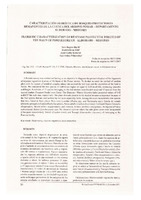Caracterización florística de bosques protectores remanentes de la cuenca del arroyo Pomar - Departamento Eldorado – Misiones
Floristic characterization of remnant protective forests of the basin of Pomar stream – Eldorado - Misiones
Date
2007-12-01Author
Barth, Sara Regina
Eibl, Beatriz Irene
Kozarik, Juan Carlos M.
Palavecino, José Aníbal
Metadata
Show full item recordAbstract
Teniendo como objetivo diagnosticar la situación actual de los fragmentos de vegetación riparia en áreas de microcuencas del arroyo Pomar se llevó a cabo su relevamiento florístico. Para ello se empleó el método de parcelas aleatorias con sistema de muestreo estratificado en función a suelo y exposición del terreno a inundaciones. Fueron consideradas las especies arbóreas con individuos mayores o iguales a 0,05 m de dap midiendo en los mismos diámetro y altura. Se hallaron presentes 73 especies pertenecientes al estrato 1 (área no inundable) y 17 especies al estrato 2 (con mayor frecuencia de inundaciones). El índice de diversidad de Shannon / Weaver arrojó valores de 1.42 y 0.97 para ambos estratos respectivamente. La diversidad vegetal presente en bosques protectores de las márgenes de los arroyos estudiados es importante en cuanto a especies de valor frutífero que sirven de alimento para la fauna, principalmente aves. Entre las especies de árboles más características que se pudieron encontrar en estas formaciones cabe mencionar los Laureles (Ocotea spp.y Nectantdra spp.), Canela de venado (Helietta apiculata.), Cocú (Allophyllus edulis), Zoita (Luehea divaricata), Camboatá blanco (Matayba eleagnoides), Taruma (Vitex megapotámica y cimosa), Araticú (Rollinia emarginata), Persiguero (Prųnus subcoriacea), Rabos (Lonchocarpus spp.). Se observaron tramos en los que la cubierta ve getal se reduce a Tacuarembó (Chusquea ramosissima), Yatevó (Guaduatrinii) y Tacuapi (Merostachis clausseni) pertenecientes a la familia Poaceae. A floristic survey was carried out having as an objective to diagnose the present situation of the fragments of riparian vegetation in areas of the basin of the Pomar stream. To do that we used the method of random plots with the system of stratified samples taking into account the soil type and the exposition of the land to floods. We considered the tree species of individuals higher or equal to 0,05 m of dbh, measuring diameter and height. A richness of 73 species belonging to the first stratum (non flooded area) and 17 species from the second stratum (frequent floods) were found. The Shannon / Weaver diversity index presented values of 1.42 and 0.97 for each case, respectively. The plant diversity present in the studied streams is important because of the fruit species that are used as food by the fauna especially birds. Among the most characteristic tree species that were found in these places there were Laureles (Ocotea spp. and Nectantdra spp.), Canela de venado (Helietta apiculata.), Cocú (Allophyllus edulis), Azota caballo (Luehea divaricata), Camboatá blanco (Matayba eleagnoides), Taruma (Vitex megapotámica and cimosa), Araticú (Rollinia emarginata), Persiguero (Prunus subcoriacea), Rabos (Lonchocarpus spp). We observed sections where the only plant cover were Tacuarembó (Chusquea ramosissima), Yatevó (Guadua triniii) and Tacuapi (Merostachis clausseni) all belonging to the Poaceae family.
Collections
- Revista Yvyraretá [351]
The following license files are associated with this item:




